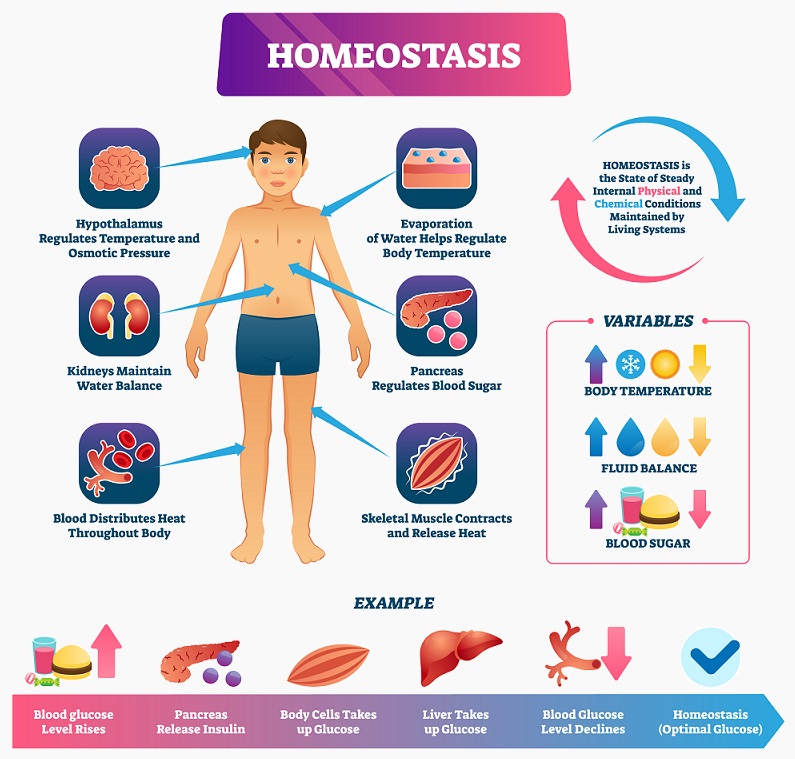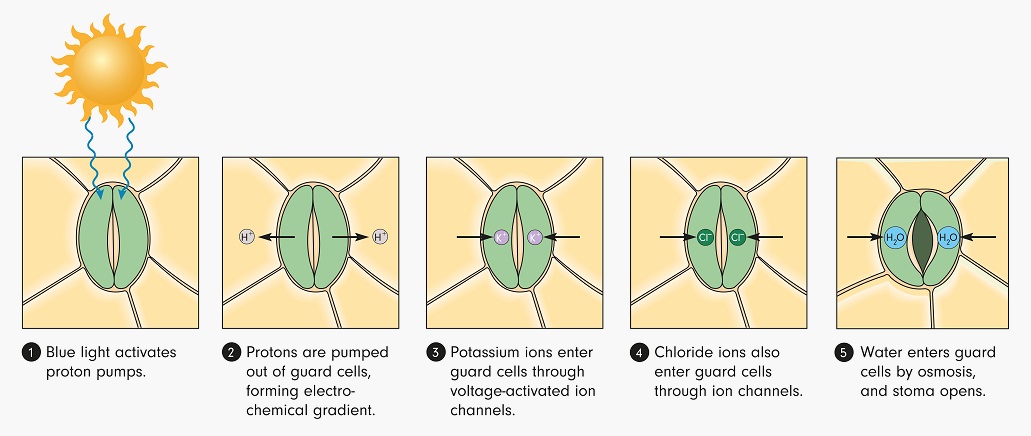[LS1-3] Feedback Mechanisms and Homeostasis
This standard focuses on how an organism maintains homeostasis through a large number of negative and positive feedback mechanisms.
Resources for this Standard:
Here’s the Actual Standard:
Plan and conduct an investigation to provide evidence that feedback mechanisms maintain homeostasis.
Standard Breakdown
There are 3 major concepts that should be demonstrated by the investigation:
Homeostasis
Homeostasis can be thought of as an organism’s fight to stay alive. As the temperature gets colder outside, your body increases circulation to keep your important organs at the right temperature. Another good example is maintaining sugar levels within the bloodstream after a meal. This delicate balance must be maintained for cells to get the nutrients, oxygen, and water that they need while waste products cells produce are removed.

A more formal definition of homeostasis is the ability of an organism to resist change or overcome disruptions in equilibrium in order to maintain a stable internal environment. This is true whether you are talking about a single-celled organism or a blue whale. Typically, internal conditions are contained by either negative feedback loops or positive feedback loops.
Negative Feedback Loop
A negative feedback loop counteracts a stimulus. So, if your blood pressure goes up, a negative feedback loop brings it back down. If your blood sugar rises, a negative feedback loop brings it back down. Negative feedback loops work through a number of different biochemical methods, though the general outline is always the same. Some condition (blood pressure, oxygen level, temperature) causes a process to activate. This process then counteracts the condition that set it off. This serves to keep a number of conditions in your body at a “set” level. While they will go up and down a little bit, they are largely constrained within a set of boundaries. It should be noted that the feedback mechanisms work by reversing the stimulus, whichever direction that stimulus is going. In the blood sugar example, the pancreas releases insulin when blood sugar levels are increasing. This causes blood sugar levels to decrease, reversing the trend back to normal. When blood sugar levels are low and decreasing, another negative feedback mechanism tries to increase blood sugar levels. This reverses the original stimuli until the system is back at equilibrium.
Positive Feedback Mechanisms
Organisms cannot always live in equilibrium, and some process must be carried out until completion. Good examples of this in an individual organism are giving birth, sending signals through nerves, and blood clotting – all of which must be carried out to completion for organisms to survive. Positive feedback mechanisms work in the opposite direction, compared to negative feedback mechanisms. Instead of reversing a stimulus, positive feedback mechanisms enhance or increase the stimulus. Blood clotting is a good example. Injured tissue releases a chemical that causes clotting factors in your blood to activate. These factors activate blood platelets – which start to stick together. These platelets recruit more platelets to the injured site. This process reinforces itself until a blood clot has completely sealed off the wound, stopping the release of chemicals from injured cells. The important aspect of positive feedback mechanisms is that some processes must be completed in order to return to a state of homeostasis.

A little clarification:
The standard contains this clarification statement: Examples of investigations could include heart rate response to exercise, stomate response to moisture and temperature, and root development in response to water levels. Though there are many other examples, let’s take a quick look at each of these suggestions:
Heart Rate and Exercise
When you begin exercising, your muscle cells start using tremendous amounts of oxygen. This activates many different feedback mechanisms. To contract, muscle cells must create and utilize ATP. To create ATP, cells need oxygen, which they rapidly absorb from the bloodstream. This downward movement of oxygen levels stimulates areas in your brain to increase breathing and heart rate. If you maintain high levels of exercise, your heart rate and breathing will stay elevated to counteract the usage of oxygen. When you stop, the negative feedback mechanism is turned off, and your heart rate returns to baseline.
Stomate Response to Moisture and Temperature
Stomates are the tiny openings on the leaves of plants that allow water to exit, allowing more water to be drawn up in the roots in the process of transpiration. Stomates are thought to operate with feedback mechanisms that keep the internal water levels, carbon dioxide levels, and oxygen levels within particular bounds. Opening the stomates allows water to exit, and carbon dioxide to enter. When plants are actively photosynthesizing, they need more carbon dioxide to create sugar. In most plants, this process is driven by sunlight – acting as a positive feedback mechanism to hold the stoma open. You can see this process in the image below:

Root Development to Water Levels
Roots grow toward water – a process that operates on a positive feedback mechanism. When water is discovered by a root tip, more growth occurs. More growth drives the root towards the water source, causing it to get into more water and subsequently grow more. This is essentially how roots find not only water but sources of nutrients and minerals as well.
Other Homeostasis Mechanisms in the Body

This image shows a number of different mechanisms used to preserve homeostasis, controlled by both the parasympathetic and sympathetic nervous systems.
What to Avoid
This NGSS standard also contains the following Assessment Boundary: Assessment does not include the cellular processes involved in the feedback mechanism. Here’s a little more specificity on what that means:
Cellular Processes in Feedback Mechanisms:
This assessment boundary is fairly straightforward. Simply stop at the level of the cell. You can even say what specific cells contribute to the process, but leave out any complicated cellular machinery involved in the process. For instance, in talking about blood sugar levels you can discuss the actions of the pancreas and liver and how cells in those organs release insulin and glucagon (respectively). However, you should not discuss how insulin binds to insulin receptors on cells, causing them to bring glucose-importing proteins to the surface of the cell to intake glucose. Likewise, you don’t need to cover the process of how glucagon causes the liver to convert glycogen into glucose that it releases into the bloodstream.
